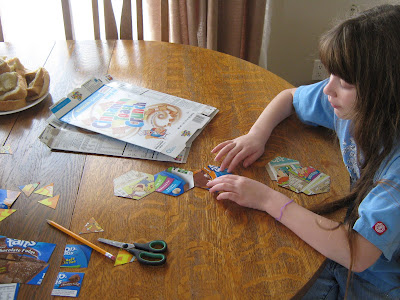
We found this video demo for finger knit flowers, last week, through A Magical Childhood.
 And, it's been just great, because I was having a terrible time teaching left handed, A (age 9), to crochet, and knit, and both crafts are too difficult yet, for the younger girls (ages 4 and 6). But, they can all finger knit, and crochet (what's in the video above, is probably what we would call finger crochet).
And, it's been just great, because I was having a terrible time teaching left handed, A (age 9), to crochet, and knit, and both crafts are too difficult yet, for the younger girls (ages 4 and 6). But, they can all finger knit, and crochet (what's in the video above, is probably what we would call finger crochet).They've been having a terrific time crocheting out chains, and turning them into flowers.

Which we've hooked onto green pipe cleaners, with bits of white pipe cleaner...


...for pretty bouquets...

...and sewn onto single, finger crocheted, chains, for necklaces...

...and flower crowns.

We also found out we could turn the double crochet chains into hearts.
You have to begin with a chain that's about 6 feet long, then crochet it on itself, as for the flowers in the video above, leaving a long tail for sewing it up.

Lay it out flat, and fold both ends toward the middle (in the picture below, only one side is folded in), and sew them down.

Fold the ends in again, toward the middle (both sides are done in the picture below), and sew them down.

Stitch the loose end, on the needle, to the middle of one of the sides, and sew it through the middle of the other side...

...pulling the two sides together.

Then, stitch back and forth, through the sides, to the bottom, pulling the stitches tighter at the bottom, to make the point of the heart.

You can tie off, and weave your loose end in now, or run the needle with the loose end up through the top of one side of the heart...

...then through the other side, tying off...

...to make a necklace. I think it's a lot simpler, than I made it sound, so hopefully, I didn't confuse anyone, too much.

It's great to be a homeschooler.




































